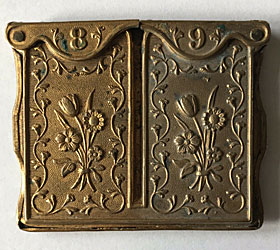The Albert Needle Case
Patent/design registration not found

Needle Case (photograph from eBay)
Design Details
Needle Case Type: |
Flat-Names |
Patent/Registered to: |
Unknown |
Patent/Design Representation #: |
Unknown |
Patent/Design Registration Date: |
unknown |
Location of Patent/Design Registration: |
Unknown |
Reference #: |
Unknown |
Dimensions: |
6 x 5 cm |
Material: |
Brass |
Name Variations: |
unsigned |
Other Variations: |
None |
Additional Photographs


Back view closed and side view with top open (photographs from eBay)


Back view with top closed and back view with top open (photographs from eBay)
Thank you
A special thank you goes to Rob and his mother Elizabeth Waciorski for finding this needle case and selling it on eBay so that Terry Meinke, the author of this website,
could bid on it and add it to her collection. Terry first met Elizabeth at the Thimble Collectors International conference in Kansas City in 2014. Then she met Rob
and Elizabeth for lunch one day when Terry visited London in 2015. Terry saw Elizabeth again at the Dorset Thimble Society meeting in Bournemouth, UK in 2017. Terry
hopes to see them both again someday when she returns to London.

Left to right: Elizabeth, Rob and Terry in London, 2015.

Left to right: Terry, Lynda Herrod and Elizabeth in Bournemouth, 2017.
Facts
Albert was born in the Saxon duchy of Saxe-Coburg-Saalfeld to a family connected to many of Europe's ruling monarchs. In 1840, at the age of 20, Albert married his cousin,
Queen Victoria and they had nine children. Initially he felt constrained by his role of prince consort, which did not afford him power or responsibilities. He gradually
developed a reputation for supporting public causes, such as educational reform and the abolition of slavery worldwide, and was entrusted with running the Queen's household, office
and estate

History
The Albert Memorial, directly north of the Royal Albert Hall in Kensington Gardens, London, was commissioned by Queen Victoria in memory of her beloved husband Prince Albert, who
died in 1861. Designed by Sir George Gilbert Scott in the Gothic Revival style, it takes the form of an ornate canopy or pavilion 176 feet (54 m) tall, in the style of a Gothic
ciborium over the high altar of a church, sheltering a statue of the prince facing south. It took over ten years to complete, the £120,000 cost (the equivalent of about
£10,000,000 in 2010) was met by public subscription. The memorial was opened in July 1872 by Queen Victoria, with the statue of Albert ceremonially "seated" in 1876.

Misc
TThe Great Exhibition of the Works of Industry for all Nations, also known as the Great Exhibition of 1851, was the first World’s Fair.
The idea for an international exhibition focusing on culture and industry was first proposed in the 1840’s by Prince Albert, Queen Victoria’s
husband. As a result, he became one of the fair’s main organizers. Located on 26 acres in the Hyde Park area of London, the fair’s
purpose was to show that Great Britain was the world’s leader in industrial development. It went down in history as the symbol of the
Victorian period.















